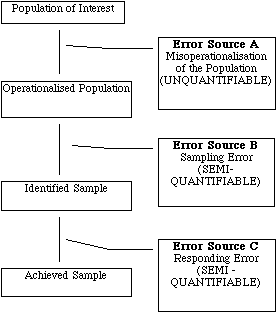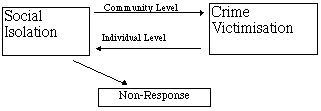
Elliott, C. and
Ellingworth, D. (1997) 'Assessing the Representativeness of the
1992 British Crime Survey: The Impact of Sampling Error and Response
Biases'
Sociological Research Online, vol. 2, no.
4, <http://www.socresonline.org.uk/2/4/3.html>
To cite articles published in Sociological Research Online, please reference the above information and include paragraph numbers if necessary
Received: 19/8/97 Accepted: 11/12/97 Published: 22/12/97
 Abstract
Abstract
 Introduction
Introduction
 Survey Methodology and
Error
Survey Methodology and
Error

Figure 1: Different Sources of Error
 Analysis and Results
Analysis and Results

where:
Ps = the proportion from the sample;
P = the proportion from the population;
n = the sample size.
| National | Census | BCS | |
| No. of areas = 572 | % | % | P-value |
| Two Pensioner Households | 9.90 | 11.56 | 0.02 |
| Owner Occupying Households | 67.76 | 71.82 | 0.00 |
| Under 5 Households | 12.81 | 13.73 | 0.10 |
| Adult Females | 52.22 | 50.34 | 0.00 |
| No Car Households | 32.56 | 30.06 | 0.02 |
| Single Parent Households | 4.10 | 4.02 | 0.52 |
| Age 16 to 24 year olds | 12.73 | 16.16 | 0.00 |
| Male Unemployment | 12.31 | 9.34 | 0.01 |
| Single Pensioner Households | 15.08 | 14.03 | 0.09 |
| Ethnic Minority Households | 4.30 | 4.73 | 0.14 |
| Single Non-pensioner Households | 11.59 | 11.40 | 0.44 |
| Regional | BCS | |||
| No. of regions = 10 | N + | N - | Sig + | Sig - |
| Two Pensioner Households | 9 | 1 | 2 | 0 |
| Owner Occupying Households | 8 | 2 | 5 | 1 |
| Under 5 Households | 9 | 1 | 1 | 0 |
| Adult Females | 0 | 10 | 0 | 5 |
| No Car Households | 1 | 9 | 0 | 4 |
| Single Parent Households | 6 | 4 | 0 | 0 |
| Age 16 to 24 year olds | 10 | 0 | 10 | 0 |
| Male Unemployment | 1 | 9 | 0 | 4 |
| Single Pensioner Households | 4 | 6 | 0 | 1 |
| Ethnic Minority Households | 7 | 3 | 2 | 0 |
| Single Non-pensioner Households | 6 | 4 | 1 | 2 |
| Variable | Sum of squared postcode sector biases |
| Single Parent Households | 1.90 |
| Adult Females | 2.21 |
| Two Pensioner Households | 3.71 |
| 16 to 24 year olds | 4.19 |
| Ethnic Minority | 4.37 |
| Under 5 Households | 5.48 |
| Single Pensioner Households | 5.92 |
| Single Non-Pensioner Households | 5.92 |
| Male Unemployed | 17.16 |
| No Car Households | 24.07 |
| Owner Occupiers | 33.47 |
| Region | No. of postcode sectors | Average of squared postcode sector biases |
| South West | 52 | 0.01 |
| West Midlands | 46 | 0.01 |
| Wales | 28 | 0.01 |
| East Anglia | 20 | 0.02 |
| South East | 112 | 0.02 |
| Yorkshire | 53 | 0.02 |
| East Midlands | 62 | 0.02 |
| North | 34 | 0.02 |
| North West | 74 | 0.02 |
| Greater London | 91 | 0.02 |
 Factors Affecting Survey
Response Rates
Factors Affecting Survey
Response Rates
| Property Crime Decile | No. of areas | Proportion of Expected Interviews Carried Out |
| 1 | 57 | 1.05 |
| 2 | 57 | 1.13 |
| 3 | 57 | 1.07 |
| 4 | 57 | 1.08 |
| 5 | 57 | 1.06 |
| 6 | 58 | 1.01 |
| 7 | 57 | 1.03 |
| 8 | 57 | 1.01 |
| 9 | 57 | 1.01 |
| 10 | 58 | 0.94 |
| Decile | Two Pensioner Hholds | Owner Occupier Hholds | Hholds with children under 5 | Adult Females | Hholds with no car | Single Parent Hholds | Aged 16-24 | Male Unemployed | Single Pensioner Hholds | Ethnic Minority Hholds | Single Non-Pensioner Hholds |
| 1st | 2.56 | 3.43 * | 0.14 | -0.81 | -1.94 | 0.45 | 0.97 | -1.82 | 0.33 | -1.22 | -0.72 |
| 2nd | 2.58 | 5.29 ** | 0.96 | -2.92 * | -5.20 ** | -2.69 | 2.90 * | -2.20 | -0.47 | -3.05 * | -1.41 |
| 3rd | 4.79 ** | 2.96 | -0.37 | -4.53 ** | -5.87 ** | -2.89 * | 5.55 ** | -2.09 | -1.41 | -0.86 | -1.94 |
| 4th | 3.83 * | 1.79 | 0.26 | -3.36 * | -3.04 * | -1.96 | 5.98 ** | -1.89 | -1.49 | -2.02 | -2.33 |
| 5th | 0.81 | 1.87 | -1.11 | -3.83 * | -2.50 | -1.01 | 12.68 ** | -1.85 | 0.42 | 0.24 | 0.44 |
| 6th | 0.73 | 0.62 | 0.68 | -2.44 | -3.01 * | -0.80 | 3.77 * | -2.19 | -1.16 | -1.71 | -0.73 |
| 7th | 3.57 * | 0.65 | -1.38 | -2.62 | -0.64 | -0.60 | 8.31 ** | 1.63 | -0.26 | -2.15 | -0.70 |
| 8th | 1.54 | 1.06 | 0.38 | -3.02 * | -3.38 * | -2.08 | 11.00 ** | -1.41 | -2.88 * | 0.72 | 0.46 |
| 9th | 2.24 | 3.43 * | 2.30 | -0.83 | -4.54 ** | 2.10 | 11.10 ** | -1.30 | -3.00 * | -0.18 | -1.57 |
| 10th | -1.22 | -0.35 | 0.12 | -3.24 * | -3.02 * | 2.26 | 11.07 ** | -0.82 | -0.70 | -2.50 | -1.44 |
| Dependent Variable | Response Rate Model | Incidence of Property Crime Model |
| constant | 0.56** | 0.21** |
| South East | 0.10** | 0.09 |
| North | 0.15** | 0.15 |
| Yorkshire | 0.14** | 0.13 |
| East Midlands | 0.12** | 0.16 |
| South West | 0.15** | 0.07 |
| West Midlands | 0.11** | 0.23* |
| North West | 0.11** | 0.12 |
| Wales | 0.14** | 0.13 |
| GLC | 0.10** | 0.06 |
| Prop. of Vacant Housing | -0.02** | 0.11** |
| Prop. of housing that is Flats | -0.05** | |
| Single Parent households | 0.01 * | |
| Affluence factor | -0.03** | |
| Prop. of population aged 5-15 | 0.08** | |
| Prop. of Council Housing | 0.04* | |
| R-bar squared | 0.21 | 0.17 |
 Conclusion and Discussion
Conclusion and Discussion

Figure 2: First Scenario

Figure 3: Second Scenario

Figure 4: Third Scenario

would weight the responses so that each area has an equal representation in any analysis. Analysis of surveys that show a wide disparity in response rates across different areas may be made more reliable by such a weighting procedure.
 Notes
Notes2 Ideally, we would employ a simultaneous equation estimation technique, but this could not be employed, as it required the a priori selection of at least a slightly different set of demographic factors to be associated with each dependent variable.
3 See data appendix for the list and definition of all explanatory variables employed.
4 An additional variable was included here; the proportion of vacant properties. This is not included in the earlier analysis as it is not available in the BCS data, as the datafile only includes completed interviews. While we know from the BCS Technical Report (Hales, 1992) that nationally 5.2% of the attempted sample was vacant, and a further 0.5% were identified as not yet built or occupied, we cannot break the data down to specific areas. Clearly the number of vacant properties has a direct impact on response rates, and less directly on crime rates, so the census-derived variable was used here.
COHEN, L.E. and FELSON, M. (1979) 'Social Change and Crime Trends: A Routine Activity Approach' American Sociological Review, Vol 44: pp 588-608
HALES, J. (1992) British Crime Survey (England and Wales) Technical Report. London: SCPR.
MAUNG, N.A. (1995) 'Survey Design and Interpretation of the British Crime Survey' in M. Walker (editor) Interpreting Crime Statistics. Clarendon Press: Oxford.
REISS, A.J. (1986) 'Why are Communities Important in Understanding Crime?' in D.J. Evans, N.R. Fyfe, and D.T. Herbert (editors) Crime, Policing and Place:Essays in Environmental Criminology. London, Routledge.
SHAW, C.R. and MCKAY H.D. (1942), Juvenile Deliquency and Urban Areas. Chicago: University of Chicage Press.
TRICKETT, A., OSBORN, D.R., SEYMOUR, J. and PEASE, K. (1992) 'What is Different about High Crime Areas?', British Journal of Criminology, vol. 32, no. 1, pp. 81 - 89.
TRICKETT, A., ELLINGWORTH, D., HOPE, T. and PEASE, K. (1995) 'Crime Victimisation in the Eighties: Changes in Area and Regional Inequality', British Journal of Criminology, vol. 35, no. 3, pp. 360 - 365.
WILSON, J.Q. and KELLING, G. (1982) 'Broken Windows', The Atlantic Monthly, March, pp. 29 - 38.
 Appendix A: Variable Definitions
Appendix A: Variable DefinitionsThe proportion of all permanent households containing two or more pensioners, and nobody else. Pensioners are defined as men aged 65 or over, and women aged 60 or over.
BCS
The proportion of all permanent households containing two or more pensioners. Pensioners are defined as above.
The proportion of all households which are owned or being bought by the occupiers. Homes which are tied to a job, and shared-ownerships are not included (this is not a category in the BCS at all).
The proportion of all households with at least one child under 5 years of age.
The proportion of households not owning a car, van, or other motor vehicle (not including motorbikes).
The proportion of households containing only one adult, and at least one child.
The proportion of the population aged between 16 and 24.
The proportion of all households exclusively containing one pensioner. Pensioners are defined as above.
The proportion of all households containing exclusively one non-pensioner, and no children.
The proportion of economically active males who are unemployed, or on a government training scheme.
BCS
The proportion of economically active male heads of household who are unemployed.
The proportion of heads of household who describe themselves as Black (Caribbean, African or other Black); Indian, Pakistani, or Bangladeshi; Chinese; or other non-White.
 Appendix B: Demographic
Proportions For Property Crime Deciles
Appendix B: Demographic
Proportions For Property Crime Deciles
Proportion of Two Pensioner Households | Proportion of Households with no Car | Proportion of Single Pensioner Households |